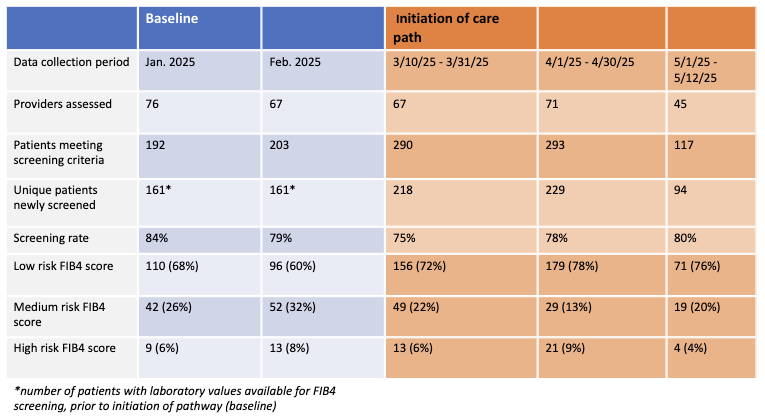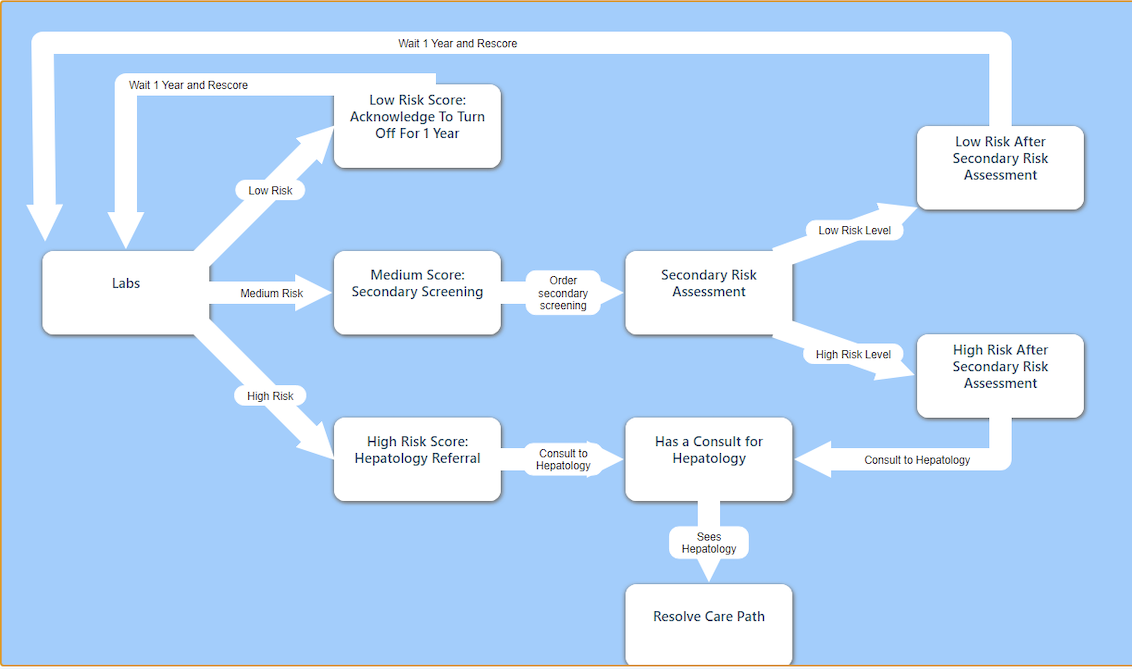Monday Poster Session
Category: Liver
P3669 - Successful Implementation of MASH Screening Guidelines for Detection of Advanced Fibrosis in High-Risk Patients in a Primary Care Setting Using Electronic Health Record-Based Care Pathway Infrastructure
Monday, October 27, 2025
10:30 AM - 4:00 PM PDT
Location: Exhibit Hall

Brendan McQuillen, MD, MS
Rush University Medical Center
Chicago, IL
Presenting Author(s)
Brendan McQuillen, MD, MS, Sujit Janardhan, MD, PhD, Nancy Reau, MD, FACG, Ruth Kniuksta, , Nagarjuna Tippireddy,
Rush University Medical Center, Chicago, IL
Introduction: The prevalence of metabolic dysfunction-associated steatotic liver disease (MASLD) is increasing, particularly among individuals with metabolic risk factors. Left undetected, it can lead to advanced liver disease-related complications. Screening guidelines for advanced hepatic fibrosis have been established for patients with metabolic risk factors. The optimal methodology by which to institute these screening guidelines is unclear. We sought to optimize a screening algorithm for advanced hepatic fibrosis using electronic health record (EHR) care pathway infrastructure.
Methods: We performed an extensive exploratory analysis of electronic health record, patient, and provider-based factors that could influence the success of screening implementation. Informed by this data, we developed a de novo screening pathway using EHR care pathways infrastructure. We then instituted this pathway in a resident primary care clinic at a large, urban academic medical center. Providers were given structured education on MASH pathophysiology and screening guidelines. Preliminary data on pathway screening effectiveness in at-risk populations was collected.
Results: The factors that most strongly influenced screening in structured and unstructured interviews effectiveness included enriched patient population, provider engagement, ease of implementation/execution and visibility/intrusiveness. Structured resident education resulted in a significant improvement in awareness and knowledge of noninvasive testing and current practice guidelines for screening and referral, t(38) = 7.7, p < 0.001, t(38) = 10.4, p < 0.001. The care path algorithm was designed to act as a silent best practice advisory (BPA) that advances as screening tasks are completed (Fig. 1). The algorithm improved identification and risk stratification of patients for whom screening data was available at the time of provider visits. Preliminary analysis suggests low rates of engagement with resultant screening data by providers.
Discussion: A screening algorithm for advanced hepatic fibrosis using EHR care path infrastructure is an effective method for identifying, tracking & risk-stratifying for advanced fibrosis in patients with metabolic risk factors. The modality provides extensive support for monitoring practice adherence to screening guidelines. Preliminary data suggests that ongoing education and incentive may be critical for effective engagement and completion of the care pathway, even after patients have been risk stratified for providers.

Figure: Fig. 1: Schematic of the MASH care pathway algorithm

Figure: Fig. 2: Patient & provider data before (baseline) and after implementation of electronic medical record-based care pathway
Disclosures:
Brendan McQuillen indicated no relevant financial relationships.
Sujit Janardhan indicated no relevant financial relationships.
Nancy Reau: AbbVie – Grant/Research Support. Arbutus – Advisor or Review Panel Member. Gilead – Advisory Committee/Board Member, Grant/Research Support. Salix – Advisory Committee/Board Member, Grant/Research Support. VIR – Advisory Committee/Board Member, Grant/Research Support.
Ruth Kniuksta indicated no relevant financial relationships.
Nagarjuna Tippireddy indicated no relevant financial relationships.
Brendan McQuillen, MD, MS, Sujit Janardhan, MD, PhD, Nancy Reau, MD, FACG, Ruth Kniuksta, , Nagarjuna Tippireddy, . P3669 - Successful Implementation of MASH Screening Guidelines for Detection of Advanced Fibrosis in High-Risk Patients in a Primary Care Setting Using Electronic Health Record-Based Care Pathway Infrastructure, ACG 2025 Annual Scientific Meeting Abstracts. Phoenix, AZ: American College of Gastroenterology.
Rush University Medical Center, Chicago, IL
Introduction: The prevalence of metabolic dysfunction-associated steatotic liver disease (MASLD) is increasing, particularly among individuals with metabolic risk factors. Left undetected, it can lead to advanced liver disease-related complications. Screening guidelines for advanced hepatic fibrosis have been established for patients with metabolic risk factors. The optimal methodology by which to institute these screening guidelines is unclear. We sought to optimize a screening algorithm for advanced hepatic fibrosis using electronic health record (EHR) care pathway infrastructure.
Methods: We performed an extensive exploratory analysis of electronic health record, patient, and provider-based factors that could influence the success of screening implementation. Informed by this data, we developed a de novo screening pathway using EHR care pathways infrastructure. We then instituted this pathway in a resident primary care clinic at a large, urban academic medical center. Providers were given structured education on MASH pathophysiology and screening guidelines. Preliminary data on pathway screening effectiveness in at-risk populations was collected.
Results: The factors that most strongly influenced screening in structured and unstructured interviews effectiveness included enriched patient population, provider engagement, ease of implementation/execution and visibility/intrusiveness. Structured resident education resulted in a significant improvement in awareness and knowledge of noninvasive testing and current practice guidelines for screening and referral, t(38) = 7.7, p < 0.001, t(38) = 10.4, p < 0.001. The care path algorithm was designed to act as a silent best practice advisory (BPA) that advances as screening tasks are completed (Fig. 1). The algorithm improved identification and risk stratification of patients for whom screening data was available at the time of provider visits. Preliminary analysis suggests low rates of engagement with resultant screening data by providers.
Discussion: A screening algorithm for advanced hepatic fibrosis using EHR care path infrastructure is an effective method for identifying, tracking & risk-stratifying for advanced fibrosis in patients with metabolic risk factors. The modality provides extensive support for monitoring practice adherence to screening guidelines. Preliminary data suggests that ongoing education and incentive may be critical for effective engagement and completion of the care pathway, even after patients have been risk stratified for providers.

Figure: Fig. 1: Schematic of the MASH care pathway algorithm

Figure: Fig. 2: Patient & provider data before (baseline) and after implementation of electronic medical record-based care pathway
Disclosures:
Brendan McQuillen indicated no relevant financial relationships.
Sujit Janardhan indicated no relevant financial relationships.
Nancy Reau: AbbVie – Grant/Research Support. Arbutus – Advisor or Review Panel Member. Gilead – Advisory Committee/Board Member, Grant/Research Support. Salix – Advisory Committee/Board Member, Grant/Research Support. VIR – Advisory Committee/Board Member, Grant/Research Support.
Ruth Kniuksta indicated no relevant financial relationships.
Nagarjuna Tippireddy indicated no relevant financial relationships.
Brendan McQuillen, MD, MS, Sujit Janardhan, MD, PhD, Nancy Reau, MD, FACG, Ruth Kniuksta, , Nagarjuna Tippireddy, . P3669 - Successful Implementation of MASH Screening Guidelines for Detection of Advanced Fibrosis in High-Risk Patients in a Primary Care Setting Using Electronic Health Record-Based Care Pathway Infrastructure, ACG 2025 Annual Scientific Meeting Abstracts. Phoenix, AZ: American College of Gastroenterology.
